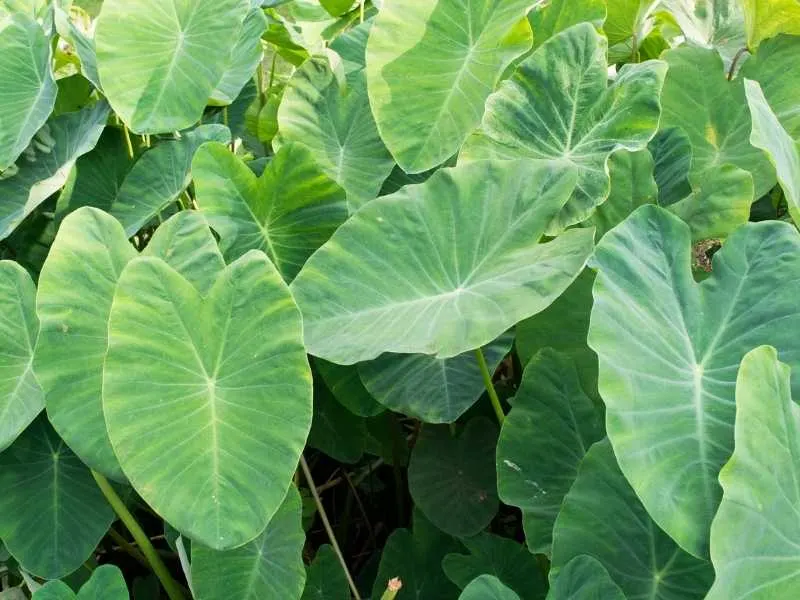Are Elephant Ear Plants Edible?
The elephant ear plant is a tropical perennial plant that is much sought after for its impressive size, stunning green foliage and enormous, heart-shaped leaves. There are four major elephant ear plant types, namely, Colocasia, Caladium, Alocasia, and Xanthosoma.
Given how lush and lovely they look, you may be wondering, are elephant ears edible?
The short answer is, it depends on the species. Some species are edible while others are not.
Read on for more information on whether elephant ear plants are edible and what to do before consuming the edible species.

Related Article:
Which Elephant Ear Plants are Edible?
Colocasia
Most colocasia varieties are edible. There are 25 species of Colocasia. C.esculenta also called Taro is native to Asia and Polynesia. Over 200 Taro varieties are grown for culinary purposes in these regions.
Many cultures around the world have been safely eating the Taro root for years now.
The Colocasia plants are tuberous. They are used in traditional Asian cuisine. Taro is a major food crop, not just for humans, but also for domesticated animals in many parts of the world.
You will find that many varieties of Colocasia are grown for their edible starchy corms or tubers called Taro. In tropical regions like Hawaii, it is a staple food and is widely cultivated. The taro plant is served at Hawaiian luaus.
There is a delicious Hawaiian dish called the Poi, which has a paste-like texture and is starchy. It is made out of fermented elephant ear corms. Not just Hawaii, but it is a common food loved by the people of Tahiti and other Pacific islands.
However, you should take care to cook them very well so that you don’t end up with gastrointestinal issues.
Alocasia
Most types of alocasia are inedible and poisonous. Whatever you see in the nursery are inedible varieties as the edible ones are grown only by the agricultural establishments.
The Alocasia is more of an ornamental plant than a food crop.
That being said, Alocasia macrorrhiza also called Giant Taro (this means like Taro, but not Taro) is edible and is rich in vitamin C, Iron and phosphorous.
The roots and the white interior of the large stems are edible. The roots are just like potatoes in flavor. You can cook the white interior of the stems, dry white and grind into powder.
The carbohydrate content in these stems is high – the highest of all the edible aroids, in fact.
The leaves are used to wrap cooked rice that is mixed with yeast for fermentation.
When you consider the edible aroids out there, the Alocasia is less palatable and more acrid of the lot.
What You Must Do Before Consuming Edible Elephant Ear Plants
Elephant ears are poisonous plants, so you may be wondering, how is it that they are consumed by many people around the world? These plants are cooked rather than eaten raw. Cooking renders the elephant ear plants harmless and palatable.
The leaves of the elephant ear plants are edible, but you must always cook them before consumption. This is because of the presence of needle-like crystals of calcium oxalate, which happen to be a skin irritant. Cooking breaks down the crystals.
The tubers should also be cooked for a long time in order to break down the naturally occurring oxalic acid.
Different Ways to Consume Elephant Ear Plants
The leaves and tubers of the edible elephant ears can all be consumed in various ways. Elephant ear plants have been cultivated for thousands of years for consumption.
The leaves can be used for wrapping rice, steamed meats and vegetables. As for the roots, it is pounded well to an edible paste called Poi.
You can harvest the tubers, refrigerate them for several weeks and cook them when needed.
What Do Elephant Ear Plants Taste Like?
The leaves of elephant ear plants taste just like spinach. The cooked corms or tubers have a flavor that is very much akin to potatoes. The texture of the corms is lightly mealy, and you can roast, fry, boil, mash or grate them.
The best part about taro is that it doesn’t fall apart when you cook it, and it absorbs flavors like a sponge!
Are Elephant Ears Edible? Conclusion
Elephant ears are incredibly gorgeous plants. If you have been wondering if they are safe for consumption, we hope you got your answers after reading this guide.
Some species of elephant ears are a major source of food in many regions of the world. They are mainly grown for their edible tubers or corms, and sometimes for their leaves.
Every part of the elephant ear plant has the acrid compound, calcium oxalate, which can lead to stomach issues when ingested without cooking. Be sure to cook elephant ear leaves and corms very well before eating.
You should also keep elephant ear plants out of reach of children and pets since these plants are poisonous.

